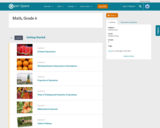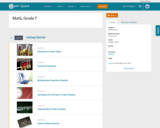
An open-ended assessment using ratios and rates.
- Subject:
- Mathematics
- Material Type:
- Lesson Plan
- Provider:
- BetterLesson
- Date Added:
- 12/01/2022

An open-ended assessment using ratios and rates.

This resource from the CIA World Factbook provides a detailed fact sheet of Peru. The content covers the country's geography, people, government, economy, communications, transportation, military, and transnational issues. It includes images of maps and the flag, as well as photos of the country. This resource requires Java.

Get independent practice working with ratios, rates and unit rates. Each incorrect response gets a text box explanation and another try. Correct responses are confirmed.

Brush up on your math skills relating to ratios then try some practice problems to test your understanding.

In this KQED infographic, find out how much an adult in different-sized households needs to make to pay for basic monthly living expenses. In the accompanying classroom activity, students solve real-life problems involving rate and ratio that involve calculating whether minimum wage in their state is a living wage. They learn whether minimum-wage pay can cover expenses such as food, housing, transportation, and medical care. They then compare their findings with data shown on bar graphs representing living wage and minimum wage in California. To get the most out of this activity, students should be comfortable with arithmetic with dollars and cents into the ten thousands.

Students will be making sense of problems and looking for structure in this lesson about real life rates and unit rates.

Gain a basic understanding of ratios and rates by watching this easy to understand video tutorial. Additional resources are available as part of a paid subscription service. [8:49]


Putting Math to Work
Type of Unit: Problem Solving
Prior Knowledge
Students should be able to:
Solve problems with rational numbers using all four operations.
Write ratios and rates.
Use a rate table to solve problems.
Write and solve proportions.
Use multiple representations (e.g., tables, graphs, and equations) to display data.
Identify the variables in a problem situation (i.e., dependent and independent variables).
Write formulas to show the relationship between two variables, and use these formulas to solve for a problem situation.
Draw and interpret graphs that show the relationship between two variables.
Describe graphs that show proportional relationships, and use these graphs to make predictions.
Interpret word problems, and organize information.
Graph in all quadrants of the coordinate plane.
Lesson Flow
As a class, students use problem-solving steps to work through a problem about lightning. In the next lesson, they use the same problem-solving steps to solve a similar problem about lightning. The lightning problems use both rational numbers and rates. Students then choose a topic for a math project. Next, they solve two problems about gummy bears using the problem-solving steps. They then have 3 days of Gallery problems to test their problem-solving skills solo or with a partner. Encourage students to work on at least one problem individually so they can better prepare for a testing situation. The unit ends with project presentations and a short unit test.

Students work in a whole-class setting, independently, and with partners to design and implement a problem-solving plan based on the mathematical concepts of rates and multiple representations (e.g., tables, equations, and graphs). They analyze a rule of thumb and use this relationship to calculate the distance in miles from a viewer's vantage point to lightning.Key ConceptsThroughout this unit, students are encouraged to apply the mathematical concepts they have learned over the course of this year to new settings. Help students develop and refine these problem-solving skills:Creating a problem-solving plan and implementing the plan systematicallyPersevering through challenging problems to find solutionsRecalling prior knowledge and applying that knowledge to new situationsMaking connections between previous learning and real-world problemsCommunicating their approaches with precision and articulating why their strategies and solutions are reasonableCreating efficacy and confidence in solving challenging problems in the real worldGoals and Learning ObjectivesCreate and implement a problem-solving plan.Organize and interpret data presented in a problem situation.Analyze the relationship between two variables.Create a rate table to organize data and make predictions.Apply the relationship between the variables to write a mathematical formula and use the formula to solve problems.Create a graph to display proportional relationships, and use this graph to make predictions.Articulate strategies, thought processes, and approaches to solving a problem, and defend why the solution is reasonable.


Getting Started
Type of Unit: Introduction
Prior Knowledge
Students should be able to:
Understand ratio concepts and use ratios.
Use ratio and rate reasoning to solve real-world problems.
Identify and use the multiplication property of equality.
Lesson Flow
This unit introduces students to the routines that build a successful classroom math community, and it introduces the basic features of the digital course that students will use throughout the year.
An introductory card sort activity matches students with their partner for the week. Then over the course of the week, students learn about the routines of Opening, Work Time, Ways of Thinking, Apply the Learning (some lessons), Summary of the Math, Reflection, and Exercises. Students learn how to present their work to the class, the importance of students’ taking responsibility for their own learning, and how to effectively participate in the classroom math community.
Students then work on Gallery problems, to further explore the resources and tools and to learn how to organize their work.
The mathematical work of the unit focuses on ratios and rates, including card sort activities in which students identify equivalent ratios and match different representations of an equivalent ratio. Students use the multiplication property of equality to justify solutions to real-world ratio problems.

Review the ways classroom habits and routines can strengthen students’ mathematical character. Explain what a Gallery is and how to choose a Gallery problem to solve. Direct students to choose one of three Gallery problems that introduce the unit’s technology resources. The three Gallery problems combine working with ratios and rates with the application resources available with this unit.Key ConceptsStudents understand that a Gallery gives them a choice of problems to solve. Students think about the features of the problems to use when choosing a problem. Students know how to work on a Gallery problem and present a solution.Goals and Learning ObjectivesKnow how to choose a problem from a Gallery.

Doubling something isn't always easy! See if you can figure out why if Tito sells his new pizza for $19.99 he'll be in trouble. Use what you know about area, rates, and proportions to figure out how much Tito should charge or what the dimensions of the new pizza should be in this real world application of math.

Students experiment to see if the temperature of two clear colorless solutions affects how fast they react.

In this activity, students use the motion detector to collect position data and study the relationship between position and velocity. They explore the relationship between functions and their derivatives. Students learn to connect mathematical relationships to real-world phenomena.

In this lesson, students will use ratios, rates, and unit rates to solve problems.

Students will learn what causes reactions and what affects the rates of reaction through data collected by conducting several simulated experiments.

Explore what makes a reaction happen by colliding atoms and molecules. Design experiments with different reactions, concentrations, and temperatures. When are reactions reversible? What affects the rate of a reaction?